Fiat is unveiled a new innovative TwinAir two-cylinder 85 HP (900 cc) to celebrate the Fiat 500's third birthday, Both the Fiat 500 and 500C TwinAir have a 2-cylinder 900 cc turbo engine that develops 85 hp and 145 Nm of torque.
The new versions will be available in showrooms from September 2010. The Fiat 500 TwinAir and the Fiat 500C TwinAir will be available with a choice between a Dualogic robotised gearbox, With CO2 emissions of 92g/km with the Dualogic robotised gearbox and 95g/km with the manual, Fiat says the TwinAir emits 30 percent less CO2 than engines of equal performance. The engine is also 23 percent shorter and 10 percent lighter than medium-sized four-cylinder engines of similar performance.
The 51kW/102Nm engine in the 1.2i Pop is currently the smallest engine offered in the Australian range, while the 1.3 JTD Lounge features the most frugal engine, with combined cycle fuel consumption of 4.2 litres/100km.


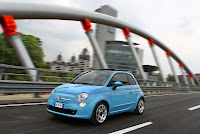

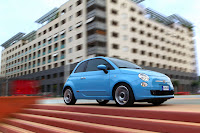









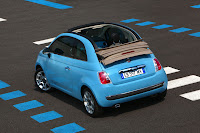
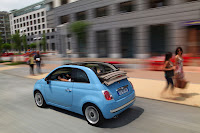







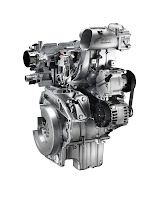
Press release
A memorable event was organised, once again in Turin, on 4 July 2007 to introduce the new Fiat 500, exactly 50 years after the Fiat 500. Since then, the second generation of the model that epitomised the history of Italian cars was quick to conquer everyone’s hearts. For the many enthusiasts and customers worldwide, Fiat decided to celebrate each birthday of the little 500 with special events and by introducing highly interesting innovations. In 2008, picnics were organised in the main European capitals and the powerful 500 Abarth was introduced. The same happened in 2009 for the international presentation of the Fiat 500C, the original cabriolet version, which pays homage to the style of the 1957 open top, which received over 32,000 orders in only a few months. And today, to celebrate the model’s third birthday, Fiat is introducing an innovative TwinAir two-cylinder 85 HP (900 cc), which will be marketed starting from next September on the 500 (saloon and cabrio alike).
The first of a new family of two-cylinder engines
made by FPT - Fiat Powertrain Technologies, it implements the revolutionary MultiAir system combined with specific fluid dynamics optimised for maximum fuel efficiency. Furthermore, by taking the concept of downsizing to the extreme and masterfully tuning the basic mechanics, the new family – delivering from 65 to 105 HP – emits 43% less CO2 than an engine of equal performance.
Significantly the new TwinAir 85 HP two-cylinder engine will complement the many technological solutions already adopted by the Fiat 500 to contain consumption and emissions as demonstrated by the recent expansion of the engine range, now featuring a second-generation 1.3 MultiJet delivering power of up to 95 HP. With 8 injections per cycle, the 1.3 MultiJet II improves low rpm torque delivery by up to 38% and cuts CO2 emissions by 6%. Again with a focus on environmental protection, the Fiat 500 (saloon and cabrio) is available with Start&Stop, the system which temporarily stops the engine and starts it again when the car is stationary with the engine idling: this reduces urban cycle average consumption by up to 12%. The principles of the Fiat 500 range are also implemented in eco:Drive, innovative software for analysing driving behaviour and helping motorists optimise consumptions and emissions by using the USB port of the Blue&Me system.
In short, the Fiat 500 perfectly expresses the commitment of Fiat in the field of environmental protection and encourages users to adopt a more responsible, eco-friendly use of the car. It is no coincidence that, for the third year in a row, Fiat is the most environmentally-friendly of the top-selling 10 car brands in Europe, with an average CO2 emission level of 127.8 g/km, compared to the market average of 145.8 g/km (analyses carried out by the independent institution Jato Dynamics). A fundamental boost to obtaining this result was certainly given by the extraordinary growth of methane, the most eco-friendly and cost-effective fuel available on the market today. A forward-thinking direction chosen over ten years ago, that has made Fiat the undisputed European leader in factory-fitted methane systems (OEM), as demonstrated by nearly 400,000 units sold to date in the Natural Power range, which includes 14 bi-fuel (methane/petrol) models - cars and commercial vehicles - for responding to all mobility needs.
Perfectly in line with this environmental protection commitment, the brand new TwinAir 85 HP is a further step forward that will certainly increase the commercial success and international appreciation of the Fiat 500, already demonstrated by the 52 awards assigned worldwide and the goal of 500,000 units made which was reached last April, only 31 months after its release. A web initiative called “500 Thousandth” was launched to celebrate this record with the goal of creating a show car with a body completely covered with 1500 photographs of the faces of owners, celebrities and enthusiasts who contributed in various ways to the car’s extraordinary success. The Fiat 500 Thousandth is the first “collective car”, confirming the spirit of the original model with potential customers being involved from the earliest steps of design. Since 3 May 2006 and for the first time in automotive history, scores of 500 enthusiasts worldwide have been directly involved in the "500 wants you" project, an international marketing platform, and given the opportunity of saying what they want from the future car. The suggestions were picked up by Fiat Automobiles designers and engineers and turned into practical objectives to be reached with solutions and equipment as close to the expectations of potential customers as possible. In short, the Fiat 500 is truly “a car created by the people, with the people’s ideas”. Today, fiat500.com is a community of 120,000 active users from 206 different countries who are involved in over 30 online activities. The web pages have been browsed nearly 240 million times.
As an expression of Italy’s finest automotive design, the 500 is not merely a super-compact city car, but a real platform upon which Fiat Automobiles is building a whole family of cars with technology and attention to detail worthy of a higher category. That’s without forgetting that the Fiat 500 has introduced many innovations and achieved important records in its segment. For example, in 2007, it was the first car only 3.55 metres long to be awarded 5 EuroNCAP stars. Similarly, the adoption of seven standard airbags (it is the only compact to include knee bags) and the availability of advanced ESP for all engine versions (standard on the 1.4 16v 100 HP) was an absolute “première” in this class. That’s without counting that even back in 2007, the entire engine Fiat 500 range was already compliant with Euro 5 standard emission limits, three years ahead of the legal deadline. Last but not least, Fiat 500 was the first small car to offer such a wide, articulated range, typical of higher range models: by combining different versions, engines, interiors, upholstery, body colours, rims, accessories and so on, customers could choose from over 500,000 variants. Product innovations also came in thick and fast: 500 by Diesel (September 2008), 500 Pink (June 2009), 500C (July 2009), 500C by Diesel (June 2010).
Finally, Blue&Me – TomTom, the latest evolution of the Blue&Me system, will be appearing on the Fiat 500 along with the new TwinAir engine. Blue&Me – TomTom is a fully integrated infotainment system that lets you manage telephone, navigation and useful driving information functions using a practical colour touch screen interface. Furthermore, with the launch of the solution on the Fiat 500 a new mediaplayer feature will be introduced that further strengthens the Blue&Me - TomTom proposition.
Blue&Me – TomTom is conveniently and elegantly accommodated on the dashboard of the Fiat 500 to combine the safety and convenience of an integrated solution with the flexibility of portable devices. The device is the result of a partnership between Fiat Group Automobiles and TomTom, the European leader in portable navigation systems, and integrates with the car’s other systems via the Blue&Me system developed in collaboration with Magneti Marelli.
Presentation to the press on the Valentino circuit
The Fiat 500 TwinAir was presented to the international press in Valentino Park, the most famous, and oldest public park of Turin, located on the left bank of the Po river, between the monumental Umberto I (corso Vittorio Emanuele II) and Isabella (corso Dante) bridges. Home to a very rich variety of plants and birds, Valentino Park was the stage of a Formula 1 Grand Prix of the same name until 1955. In brief, a suggestive location that well embodies the combination of "power and environmental-friendliness" embedded in TwinAir technology.
The origins of the park are remote in time: the name "Valentino", of unknown origin, first appeared in the Middle Ages and since the 1600s identified a castle, one of the Residences of the Royal House of Savoy and included in the UNESCO World Heritage Sites list, and the surrounding grounds. The Valentino Park, then not public, was first landscaped in 1630 by Carlo Cognengo di Castellamonte and the project was followed up until 1660 by his son Amedeo.
A new urban phase started for Turin in the second half of the 1800s following the destruction of the city walls ordered by Napoleon and the population spiked. The modern concept of a public park came about at that time and city authorities thought of the Valentino Castle grounds. Works started in 1863-1864, based on a partial project by French architect Barillet-Deschamps. Inspired by the principles of a landscaped park with lanes, thickets and artificial dells, the project also included a small riding track and a lake (later dried) which was used as a skating rink in winter.
Even before its completion, the park staged several important national and international expositions from 1829 to 1961. A so-called medieval village and castle, a composite reconstruction, picking various styles and architectonical elements from medieval buildings in Piedmont and Valle d’Aosta, was built in 1884 for the General Italian Exposition. The park assumed today’s proportions after the 1911 exposition.
In 1935 the Italian car capital set up a racing circuit precisely in the Valentino Park area. It was 4088 metres long and the first event, which was held on 7 July, was an immediate success: Tazio Nuvolari won with Alfa Romeo, ahead of team mates Antonio Brivio and Carlo Pintacuda. Nino Farina came in fourth at the wheel of a Maserati. The starting line was in front of the Valentino Castle and the circuit was mostly inside the park. It was not an easy task to erect mobile grandstands for the audience and a tower for race officials and the press.
The event was repeated two year later, on 18 April 1937. Once again, Alfa Romeo dominated the most important class (GP single-seaters). The race was won by Antonio Brivio, followed by Nino Farina. The driver from Turin had in the meantime joined the Milan-based team. The race was 175 km long in total and the course was particularly twisty, which accounted for an average speed of only 93.629 kilometres per hour. For the sake of comparison, the Monte Carlo winner (Von Brauchitsch on Mercedes) clocked an average speed of 101.815 kilometres per hour.
The race was interrupted for a long time and resumed only after the war, when the automotive industry was attempting to pick up and restart production despite many difficulties. Competitions were in any case important test benches for advertising products.
Automobile Club Torino, on their part, invested considerable efforts and managed to set up the circuit that hosted the First Turin Grand Prix on 1 September 1946. Racing regulations were changing and although a genuine world championship was still to be organised, there were many prestigious events in which major auto makers could compete. Turin was one of these. The circuit set up was meticulous and the public responded enthusiastically. The event was international although only supercharged Alfa Romeo 158s ever won. The results were topped by Achille Varzi and Wimille. The average speed of the winner on the 283.200 km long race was 109.088 km/h because the circuit had been made faster by including a few stretches of corso Massimo D’Azeglio. Sommers of Maserati came in third. Tazio Nuvolari was forced to withdraw. The event continued after the GP with the Coppa Brezzi for cars without turbocharger and displacement of approximately 1500 cm3. Cisitalia 1100 cm3 built by local Piero Dusio dominated the class. Many champions, such as Chiron, Taruffi and Nuvolari, were invited to take part. The latter was involved in an episode that would go down in history. His steering wheel attachment snapped while he was heading the race. Not one to be put off easily, the driver drove a few more laps steering with the little lever used to fasten the wheel but he was eventually stopped by the race officials. The race was won by Dusio, a good driver as well as auto builder.
Ferrari put its name on the roll of honour a year later with Sommers driving to win at an average speed of 108.825 on a remarkable length of 540 km.
1948 was the most prestigious edition of the event. The Italian Grand Prix took place in Turin with the best drivers of the time on the starting line. The race took place during the first weekend of September under the beating rain. The strong Alfa Romeo (Wimille, Trossi and Sanesi) and Maserati (Villoresi, Ascari and Taruffi) teams clashed with the Ferraris of Farina, Sommers and Bira and the Talbots of Chiron, Rosier and Comotti. Many accidents occurred during the race. At the end Wimille drove the only remaining Alfa to the win one lap ahead of Villoresi’s Maserati.
The first Formula 1 World Championship was organised in 1950 and the Italian race took place on the Monza circuit. There were no races in Turin for two years and the Valentino circuit was to host another competition in 1952. The Turin Grand Prix was won by Gigi Villoresi of Ferrari. The Sport class animated the city circuit in 1953 and 1954, while 1955 was the last edition of the Formula 1 GP won by Alberto Ascari on Lancia, after an exciting duel with Luigi Musso of Maserati. The new Formula 1 cars were by now extremely fast. Ascari won at an average of over 141 km/h.
TwinAir 85 HP, world preview
The new two-cylinder engine family made by FPT - Fiat Powertrain Technologies, called TwinAir, is debuting in the Fiat 500 today. This is a brand-new concept on the worldwide auto scene and confirms the leadership of the Fiat Group in this field.
Using next-generation technology, the new engine implements the revolutionary MultiAir system combined with special fluid dynamics optimised for maximum fuel efficiency. Furthermore, by taking the concept of downsizing to the extreme and masterfully tuning the basic mechanics, the new family – delivering from 65 to 105 HP – emits 30% less CO2 than an engine of equal performance.
On sale from next September, the 500 will be the first Fiat model to adopt this, which will be the progenitor of a new family of engines: a 85 HP (900 cc) turbo two-cylinder with the lowest CO2 emission for a petrol engine (92 g/km with a Dualogic robotised gearbox and 95 g/km with manual gearbox) without skimping on performance or driving pleasure. This is thanks to the small-sized turbine which, combined with dedicated valve management strategies, minimises transient response times and, at the same time, keeps maximum power levels high. In this way, despite its small size, the engine ensures excellent performance and an appreciable reduction in fuel consumption: compared with a 1.2 8v, the new 85 HP turbo has 23% more power and a 30% better performance index. In fact, the performance of the two-cylinder is not only equivalent to a 1.4 16v, but consumption is a remarkable 30% lower.
Equipped in this way, the Fiat 500 reaches a top speed of 173 km/h and accelerates from 0 to 100 km/h in only 11 seconds. This remarkable performance corresponds to a significant reduction of fuel consumption and emissions: 4.1 l/100 km and 95 g/km respectively on the urban cycle (with manual gearbox), that becomes 4.0 l/100 km and 92 g/km with a Dualogic robotised gearbox. Furthermore, the Fiat 500 with TwinAir 85 HP is provided with an ECO button – positioned on the dashboard – for further cutting fuel consumption in cities and guaranteeing very eco-friendly running. Two driving modes can be selected: Normal and ECO.
In the first mode, the ECO function is off and the engine delivers the maximum available torque (145 Nm), guaranteeing prompt, brilliant response and a "sportier" driving feel. Steering assistance is also specifically calibrated for Normal mode. No indication appears on the dashboard in this mode (City is not selected). Consequently, this configuration is recommended for maximum response and full enjoyment of all available torque.
In ECO mode, instead, the emphasis is on "eco-friendly" engine running: torque delivery is cut off to 100 Nm at 1750 rpm to minimise consumption and promote a driving style more suitable for city traffic. The steering wheel is lighter (CITY mode is automatically selected). The driver only needs to press the specific button on the dashboard to activate the ECO function. The lettering ECO will appear on the panel (the letter “E” will appear on the panel if the car has a Dualogic robotised gearbox). Furthermore, the Dualogic shifting strategy also switches to ECO mode to further optimise fuel consumption.
Furthermore, compared with a medium-sized four-cylinder of equal performance, the new engine is significantly shorter (-23%) and lighter (-10%), opening the way to further developments, such as methane fuel supply or hybrid technology combinations, again on the theme of greater eco-friendliness. In particular, a methane version of the TwinAir will be available soon providing a further CO2 emission reduction, by adopting a pair of special injectors in addition to the petrol injectors on the intake manifold ducts. Improving on these fuel saving results using internal combustion engines will be difficult and alternative technologies will need to be developed. The combination of traditional engines and electric motors appears particularly promising. Due to its reduced size, the TwinAir is quite suitable for being paired with an electric engine and in general with a device located between the engine and gearbox for recovering and storing the energy that is normally wasted during braking.
Interestingly, the TwinAir 85 HP comes with “Start&Stop” as standard. This device temporarily stops the engine and restarts it, ensuring reductions in fuel consumption and noise in the passenger compartment. The Gear Shift Indicator (GSI) associated to the Start&Stop system is a genuine “co-pilot” that discreetly suggests when to shift gear, leading to more efficient use of the engine in terms of fuel consumption. For example, the GSI may suggest shifting up, by means of an indication on the control panel, to allow the engine to burn a leaner mixture, i.e. one containing less fuel, or shifting down to make best use of the available torque.
Nothing short of an engineering gem, the two-cylinder implements the revolutionary MultiAir technology developed and patented by FPT – Fiat Powertrain Technologies, which was introduced on FIRE engines last year for the first time. The heart of MultiAir is a new electro-hydraulic valve management system that reduces fuel consumption by controlling air directly via the inlet valves (without using the throttle).
MultiAir reduces polluting emissions (thanks to combustion control) and also considerably improves performance by boosting driveability with respect to a traditional petrol engine of equal displacement. In brief, the advantages of MultiAir technology applied to petrol engines are:
- maximum power boosted by 10% compared with a traditional engine of equal size;
- 15% more torque at low rpm and during transitions by applying early intake valve closing strategies to maximise the air introduced into the cylinders;
- less fuel consumption and consequently lower CO2 emissions, equal to 10% by eliminating pumping losses and precise parameter calibration for optimising combustion;
- lower polluting emissions from the engine by optimising valve control strategies during the intake stroke;
- prompter response to accelerator commands due to the constant air pressure upstream of the cylinders combined with extremely fast control of the intake valves.
Also, the new TwinAir engine takes the concept of downsizing to an extreme: by combining a small-sized engine with a next-generation turbocharger performance comparable to – or even better than – that of a larger engine is obtained but with less fuel consumption and lower emissions. Not only that, the turbo significantly increases the maximum torque, making it available at a very low rpm, with the result of offering greater flexibility and an unrivalled responsiveness compared to conventional aspirated engines.
All this comes with a simple build to the benefit of strength and reliability.
Last but not least, the new engine was painstakingly optimised and tuned. For instance, the basic two-cylinder architecture – combined with the low friction of internal parts – ranks this engine best in the world as far as friction is concerned. Furthermore, calculated simulations have been used to identify the best possible unit displacement in terms of thermo-dynamic efficiency, and the best fluid dynamic configuration to optimise and get the best out of the MultiAir system. Finally, special attention has been placed on the NVH (Noise, vibration, and harshness) aspect to ensure vibration performance at least equivalent to that of a four-cylinder, with equal performance but with a characteristic sound. For this purpose, a balancing countershaft was used to maintain optimal vibration levels in all operating conditions of the engine, from idling speed to top power.
No comments:
Post a Comment